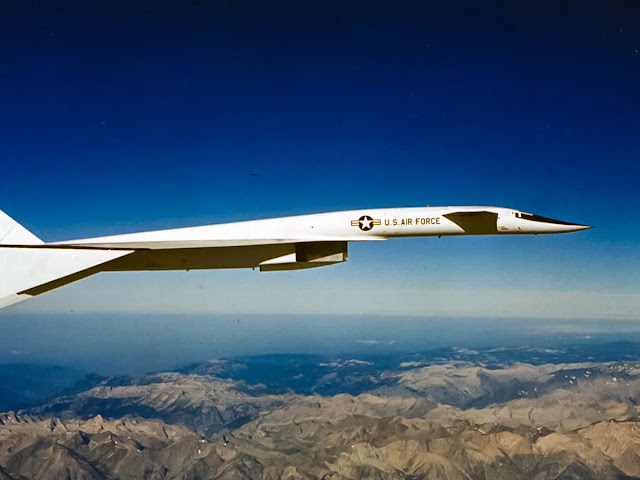
|
| The Most Spectacular Plane Ever Built: North American XB-70 Valkyrie! |
Yet it appears that she was rendered useless by technology long before her time. What happened to her and why is detailed below. The only prototype of a high-altitude, nuclear-strike bomber that could fly at Mach 3 is on display at the National Museum of the United States Air Force at Wright-Patterson Air Force Base (AFB) outside of Dayton, Ohio. The plane was first conceived of in the 1950s (at three times the speed of sound). Amazingly, this took place only sixty years after the Wright Brothers' first flight, with the futuristic-looking XB-70 "Valkyrie" taking to the skies.
It was evidence of how far airplane technology had come by the mid-20th
century.
Did the XB-70 Valkyrie ever fly?
The XB-70A was an experimental high-speed delta-wing plane that was made for the U.S. Air Force by the Los Angeles branch of North American Aviation (NAA). It was capable of reaching speeds of Mach 3, or three times the speed of sound, at altitudes above 70,000 feet (21,000 kilometers). The plan was to build a nuclear strike bomber capable of flying at high altitudes and outrunning any interceptors that might be sent after it. For the Strategic Air Command, the B-70 was supposed to be a deep-penetrating, supersonic strategic bomber with nuclear weapons.
The experimental XB-70 looks remarkably like the British-French
turbojet-powered Concorde supersonic passenger airline, which was in service
from 1976 until 2003 and also features a delta-wing profile. The B-70, on the
other hand, was likely conceived long before the high-speed passenger
airliner.
The six General Electric YJ93 engines, each of which produces 30,000 pounds of thrust before the afterburner, were supposed to allow the XB-70A to reach a top speed of Mach 3.1. It had a top speed of Mach 3.00 at its service ceiling of 75,550 feet (23,012 meters) and could reach Mach 1.90 at 35,000 feet (10,668 meters) in altitude. The B-70's maximum range was expected to be 4,290 miles, while its combat range was estimated to be 3,419 miles.
Why was the XB-70 canceled?
Military planners thought that the bomber could fly so high and so fast that
no enemy, especially the Soviet Union, could stop it. Unfortunately, the XB-70
Valkyrie couldn't outrun the development of more advanced missiles.
By the early 1960s, surface-to-air missile (SAM) technology had come a long
way, and even fast, high-altitude bombers were in danger of being shot down.
Simultaneously, cheaper intercontinental ballistic missiles (ICBMs) with
nuclear warheads were being deployed. So, the expensive B-70 bomber program
ended in 1961, and no Valkyries were ever made or flown.
How much did the XB-70 Valkyrie cost?
Each plane was estimated to cost $24.5 million (nearly $240 million in today's
money), which was far too expensive for the type of plane it was.
Even so, the US Air Force bought two XB-70As to test the aerodynamics,
propulsion, and other features of large supersonic planes. This could save the
Valkyrie from being cancelled. NASA and the Air Force were conducting research
into SST, and the XB-70 Valkyrie was an ideal testbed for their efforts. The
brazed stainless steel honeycomb and titanium used in its construction were
identical to those in the proposed SST designs, as was the ship's overall
size.
Where is a XB-70 Valkyrie now?
In September of 1964, Chief Test Pilot Alvin S. White and Colonel Joseph F.
Cotton, U.S. Air Force, flew the first XB-70A from Air Force Plant 42 in
Palmdale, California, to Edwards Air Force Base. This aircraft is now on
display at the National Museum of the United States Air Force.
In October 1965, the plane was able to fly at Mach 3, and it continued to fly
and provide valuable test data for the research program until it made its
final research flight on February 4, 1969, and was retired. Later that year,
it made its way to the museum.
The second Valkyrie made its maiden flight in July of 1965, but it was
destroyed in a midair collision in June of 1966, taking the life of the
plane's co-pilot, Maj. Carl Cross, in the process. It seems that a third
Valkyrie was never finished.


